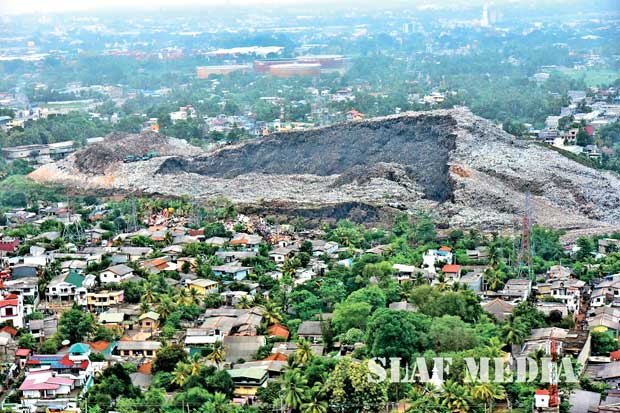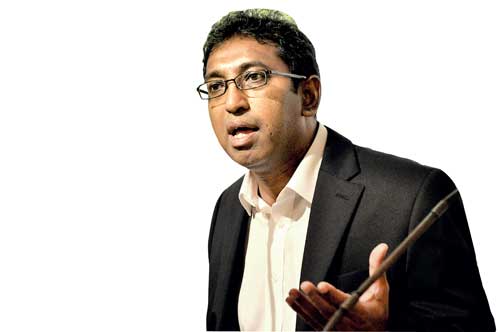Reply To:
Name - Reply Comment
The Meethotamulla residents who filed a fundamental rights petition last year stating that there were individuals and companies who were interested in purchasing the garbage for re-cycling at their own cost without harming the environment. Who held it back? Did politicians of past and present along with officials negotiate for higher commissions causing a delay in the progress?

“Solid Waste” or garbage is unwanted and non-required material arising from human and animal activities, which is in solid form.
Dr. Harsha de Silva awakened from slumber wants no more garbage dumping at Meetotamulla, but please hold: One more load awaits with all previous and present politicians responsible for the Meetotamulla disaster.

No more garbage will be dumped at this site and two temporary sites were identified this morning
- Dr. Harsha de Silva
The Deputy Foreign Affairs Minister said that the government has recognized two temporary sites to unload garbage. “No more garbage will be dumped at this site and two temporary sites were identified this morning,” - Dr. Silva. He revealed the govt’s decision to bear all funeral expenses of the victims who lost their lives and ‘immediately commence evacuations of those who are vulnerable’. He further stated, “It’s ironic that it was only a few weeks back that agreements were signed to begin ‘waste to energy’ projects to finally deal with this perennial issue.”
Facebook poll
Closing the stable door after the horses have bolted!
However, he said that it was unfortunate that even though payments had been made for those families under risk of landslides to move out, some hadn’t done so. They had even been advised to leave as recently as two days ago!
Troops looking for survivors after the massive rubbish slide (300-ft high) collapsed in Meetotamulla, suspended their search on Saturday night, having already extricated 19 bodies from the rubble and mud. The mountain collapsed after flames engulfed it late on Friday, burying around 100 houses.
FR petition filed by seven residents of Meethotamulla
The Colombo Municipal Council on September 9, 2016, informed Supreme Court of its decision not to dump garbage at Meetotamulla in Kolonnawa as it had ear-marked a plot of land in the Ja-Ela area for the purpose. This was in response to the Supreme Court order to come up with their project plans as solutions for constant garbage dumping at the above site in Kolonnawa. These facts were revealed by CMC when an FR petition filed by seven residents of the Meetotamulla area citing the CMC, UDA, Western Province Waste Management Authority, CEA, Kolonnawa MC and the Attorney General as respondents. At a previous hearing, the Supreme Court granted leave to proceed with this fundamental rights petition. The lawyer who appeared for the CMC informed Court that it had a solution to solve the issue including an arrangement to have the garbage taken to a 35-acre land in  Ja-ela. The petitioners sought a declaration from Supreme Court that the proposed development of the dumping site was an impending infringement of their fundamental rights. The petitioner stated that Kolonnawa city particularly a high residential area with a thick population density, and lamented that in the centre of this highly residential area there was a huge and rising garbage dumping site, with a massive mountain of garbage, which had now developed to over 18 acres in extent. The petition state that approximately 750 to 1,200 tons of garbage from the Colombo city was piled onto this mountain on a daily basis and that the stench was now becoming unbearable for the families and children and that there is a significant and serious health risk. Around 30 people of the area had died due to killer germs, outbreak of dengue, kidney diseases, rat fever and skin conditions.
Ja-ela. The petitioners sought a declaration from Supreme Court that the proposed development of the dumping site was an impending infringement of their fundamental rights. The petitioner stated that Kolonnawa city particularly a high residential area with a thick population density, and lamented that in the centre of this highly residential area there was a huge and rising garbage dumping site, with a massive mountain of garbage, which had now developed to over 18 acres in extent. The petition state that approximately 750 to 1,200 tons of garbage from the Colombo city was piled onto this mountain on a daily basis and that the stench was now becoming unbearable for the families and children and that there is a significant and serious health risk. Around 30 people of the area had died due to killer germs, outbreak of dengue, kidney diseases, rat fever and skin conditions.
Thousands of others in the vicinity are affected and the number of affected are increasing daily. The petitioners complained that there were sustainable solutions other than the dumping of garbage in the above manner, which could bring an end to this crisis. But these procedures are not being tried by the respondents.They also allege the respondents are taking measures to pull down another 100 houses to expand the size of the site for a further three acres, and if the proposed extension took place, there would be immeasurable, serious, irreparable and disastrous consequences to be faced. There are individuals and companies that are interested in purchasing the garbage and would recycle it at their own cost without causing any harm to the environment.
Water cannons dispersed demonstrators
The police on Sunday, May 24, 2016, used water cannons to disperse protesting residents near the Meethotamulla garbage dump in Kolonnawa. The area residents held the demonstration in front of the land used for the dumping of waste collected from the city of Colombo demanding that authorities should give them a written assurance that disposal of around 700 MT of waste daily at the 16-acre garbage dump site would be halted.
‘It is threatening the homes and lives of the people living in the area: The huge garbage dumps have slipped causing damage to a large number of houses in addition to the health risks.’, they claimed. The residents continually objected calling for the removal of the site, however, their pleas have fallen on deaf ears. Politicizing the issue insults the victims. Both previous and current governments and state officials are responsible for the disaster. The government is rather sensitive to the sufferings of the poor people.
The Finance Minister can place another Supplementary Bill for another round of luxury cars for the ministers to visit the affected area at Meethotamulla before leaving for the village New Year shows as chief guest.
History
Colombo city, for many years has been demanding to solve its waste problem but in vain. According to a former CMC official, the garbage disaster in Colombo began after 1977. The city began to develop fast and the low-lying areas used for garbage discarding were reclaimed. Low-lying lands in areas such as Kolonnawa, Mattakkuliya and Rajagiriya were used for garbage dumping. During the period 1998/99 under CBK, the World Bank was prepared to grant financial assistance to build a disposal site in Meepe in Avissawella. The cost of the project was estimated at Rs.800 million.This proposal was rejected by the then government citing various reasons such as the transport cost. (They said the ‘under-the-table’ transactions did not meet the demand)!
Bandaragama model : They did it a decade ago
Bandaragama used to have the same garbage problem as Colombo. Its roads were strewn with garbage. According to the residents of Bandaragama, the garbage issue had been huge. In 2007, the Bandaragama Township decided to go green. The then Bandaragama Pradeshiya Sabha Chairman, Lalith Ellawala kicked off a project to recycle garbage collected in the area. Technical expertise and direction were provided by the Solid Waste Management Authority, Western Province and the Ministry of Environment and Natural Resources. Today, garbage has ceased to be a problem in Bandaragama. Instead, it has become a source of income.
How is garbage recycled?
The recycling plant of the Pradeshiya Sabha occupies a small plot of land. It has 13 workers. About eight tons of garbage is collected from the town and brought to the place where it is sorted out. The biodegradable rubbish is allowed to decompose while the other collections such as polythene and plastic are sold to collectors. The plant needed only a smaller size backhoe (Bobcat type) machine to mix the decomposed garbage; the mixing is done by six workers and it takes a long time. They only have 13 employees to do the recycling work and if they have a backhoe machine, the workers will have more time.
Garbage is allowed to decompose for three months without any chemicals. They do not expose the garbage to sun. Decomposed manure needs around 15 % moisture. Once it is decomposed, it is then processed with the help of a mechanism which separates the dust. They collect the dust, packet it and sell. However, the PS noted that pubic cooperation was not at satisfactory level. There were two garbage dumps placed at many places in the town for non-decaying and decaying garbage but people dispose of their garbage haphazardly without caring to sort them thus causing hardships to the recycling workers. There is a good demand for the product. They plough back the income from sales into the plant. There are hundreds of birds eagerly waiting to eat the flies. Workers who reprocess garbage have small farms where compost made from garbage is used. They are also involved in animal husbandry. Vegetables grown from their plots are used for meals provided to workers.
The Solid Waste Management Centre at Bandaragama is admirable. Anybody can emulate it. In two years since its commencement in 2007 or by 2009, it had the expertise to provide its services to other local government institutions, though it was without space to expand its operations. With more facilities and space, they could expand their services to other parts of the country and help them overcome the garbage issue.